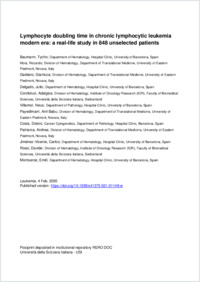Lymphocyte doubling time in chronic lymphocytic leukemia modern era : a real-life study in 848 unselected patients
- Baumann, Tycho Department of Hematology, Hospital Clinic, University of Barcelona, Spain
- Moia, Riccardo Division of Hematology, Department of Translational Medicine, University of Eastern Piedmont, Novara, Italy
- Gaidano, Gianluca Division of Hematology, Department of Translational Medicine, University of Eastern Piedmont, Novara, Italy
- Delgado, Julio Department of Hematology, Hospital Clinic, University of Barcelona, Spain
- Condoluci, Adalgisa Division of Hematology, Institute of Oncology Research (IOR), Faculty of Biomedical Sciences, Università della Svizzera italiana, Switzerland
- Villamor, Neus Department of Pathology, Hospital Clinic, University of Barcelona, Spain
- Payedimarri, Anil Babu Division of Hematology, Department of Translational Medicine, University of Eastern Piedmont, Novara, Italy
- Costa, Dolors Cancer Cytogenetics, Department of Pathology, Hospital Clinic, Barcelona, Spain
- Patriarca, Andrea Division of Hematology, Department of Translational Medicine, University of Eastern Piedmont, Novara, Italy
- Jiménez-Vicente, Carlos Department of Hematology, Hospital Clinic, University of Barcelona, Spain
- Rossi, Davide Division of Hematology, Institute of Oncology Research (IOR), Faculty of Biomedical Sciences, Università della Svizzera italiana, Switzerland
- Montserrat, Emili Department of Hematology, Hospital Clinic, University of Barcelona, Spain
-
04.02.2021
Published in:
- Leukemia. - 2021, p. 7 p
English
The prognostic significance of lymphocyte doubling time (LDT) in chronic lymphocytic leukemia (CLL) was identified when the biology of the disease was poorly understood and therapy was not effective. We assessed the clinical and biological significance of LDT in 848 CLL patients in a real-life setting and the context of new biomarkers and effective therapy. A short LDT (≤12 months) was enriched for adverse biomarkers. Patients with a rapid LDT did need therapy shortly after diagnosis (median 23 months vs. not reached; p < 0.001) and had a poorer overall survival (median 95 months vs. not reached p < 0.001). LDT, IGHV mutational status, Beta-2 microglobulin, and Rai clinical stage were independent predictors for time to first treatment in the whole series and in Binet stage A patients. No correlation was observed between LDT and response to chemoimmunotherapy. However, a short LDT along with age ≥65 years, high-risk FISH (del(17p), del(11q)), unmutated IGHV, increased Beta-2 microglobulin, and TP53 mutations predicted short survival. Moreover, the prognostic significance of LDT was independent of the CLL-IPI and the Barcelona/Brno prognostic model. LDT remains an important outcome marker in the modern CLL era and should be incorporated into the clinical assessment and stratification of CLL patients.
- Language
-
- English
- Classification
- Medicine
- License
-
License undefined
- Open access status
- green
- Identifiers
-
- RERO DOC 330255
- DOI 10.1038/s41375-021-01149-w
- ARK ark:/12658/srd1319283
- Persistent URL
- https://n2t.net/ark:/12658/srd1319283
Statistics
Document views: 182
File downloads:
- Fulltext: 311
